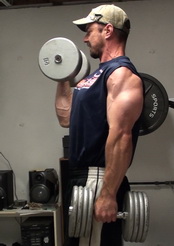Getting into good position for a barbell squat can be a challenge for those who have stiffness or tightness through the chest and shoulders.
This can force the bar to sit too high on the back and/or cause the shoulders to constantly try and rotate forward (i.e. internal rotation), which causes the upper body to pitch forward during the squat.
We want to facilitate EXTERNAL rotation at the shoulder so that you can hold the bar in position on your back without a tendency to roll it forward due to tight shoulders or tight pectoral muscles.
Don't spend 20 minutes doing mobility drills when you can do THIS in 30 seconds.
This simple mobility drill literally takes just 20-30 seconds to do and can immediately loosen up the shoulders and chest, allowing you to get into a much better position for squatting. I use it before every single squat session and it works like a charm.
You don't need any special setup...you'll just be using the exact same bar you're going to be using for squats.
The method is going be somewhat similar to PNF stretching (proprioceptive neuromuscular facilitation), where you activate the target muscle immediately before stretching it in order to "grease the wheels".
It's not exactly the same thing here, but I find the result is along the same lines (a much faster and immediate increase in mobility and flexibility than with static stretching). I've used this technique for Front Squat mobility in the forearms with great results.
If all that sounds really complex, don't worry...I'm actually making it sound more complicated than it is. The actual drill is really quite simple.
First, grab the bar exactly where you would for a squat. For me, it's index fingers on the smooth rings of the Olympic bar.

Next, duck your head under the bar as though you were about to get into position for a squat.
However, instead of actually getting into position, keep your body at an angle and allow your chest to come forward. This will give you a stretch through the chest and shoulders in the EXACT position they need to be stretched for the squat.

Now, keeping your feet planted, use an external rotation movement at the shoulders to pull yourself up towards the bar.

Hold for a few seconds, contracting the external rotation muscles at the shoulder and squeezing the lower lats and lower traps as though trying to do a behind-the-neck pull-up (FYI, you're not actually doing a pull-up and there is no "bad" action happening at the shoulder joint because there's no up-and-down movement to cause any issues...simply an isometric contraction).
This isometric contraction in the back activates the specific muscles that are going to be supporting the bar on your back.
Now lower yourself back down into the stretch position again and hold. Let your bodyweight sink forward and down to force the shoulders back and the chest to open up.

Hold for 5-10 seconds then bring yourself back up. Again, when the bar contacts your back, contract your lats and traps and squeeze and hold.

Repeat for 3-4 cycles (or more, if you like).
Now you're ready to put the bar in perfect position on your back without the mobility limitations in your chest and shoulders.
I'll be honest, I absolutely love this one. I've been doing this before every single squat session and I've noticed I can get into and keep much better position during the squat.
If you're doing any barbell squats, I HIGHLY recommend giving this quick drill a try before your next session.
If you still have issues with your upper body pitching forward, add in some calf stretching as well - this will also make a big difference in positioning.
You can use this technique with 20 Rep Single Rep Cluster Squats to build squat strength fast.
---
Are you 40...50...60 or even 70+ years old and want to build muscle and strength like you did 20 years ago?
If you feel like you're fighting a losing battle, you're ready to discover the REAL secret to REVERSING muscle loss due to aging...
*** You need to train the body systems that SUPPORT your muscle mass, not just the muscle itself. ***
These underlying support systems diminish as you age, which is why you lose muscle as you get older no matter how hard you train... but with strategic training, these systems can be regenerated.
Share This Page...
Want More Strength-Building Techniques and Programs?
You'll find them here...



